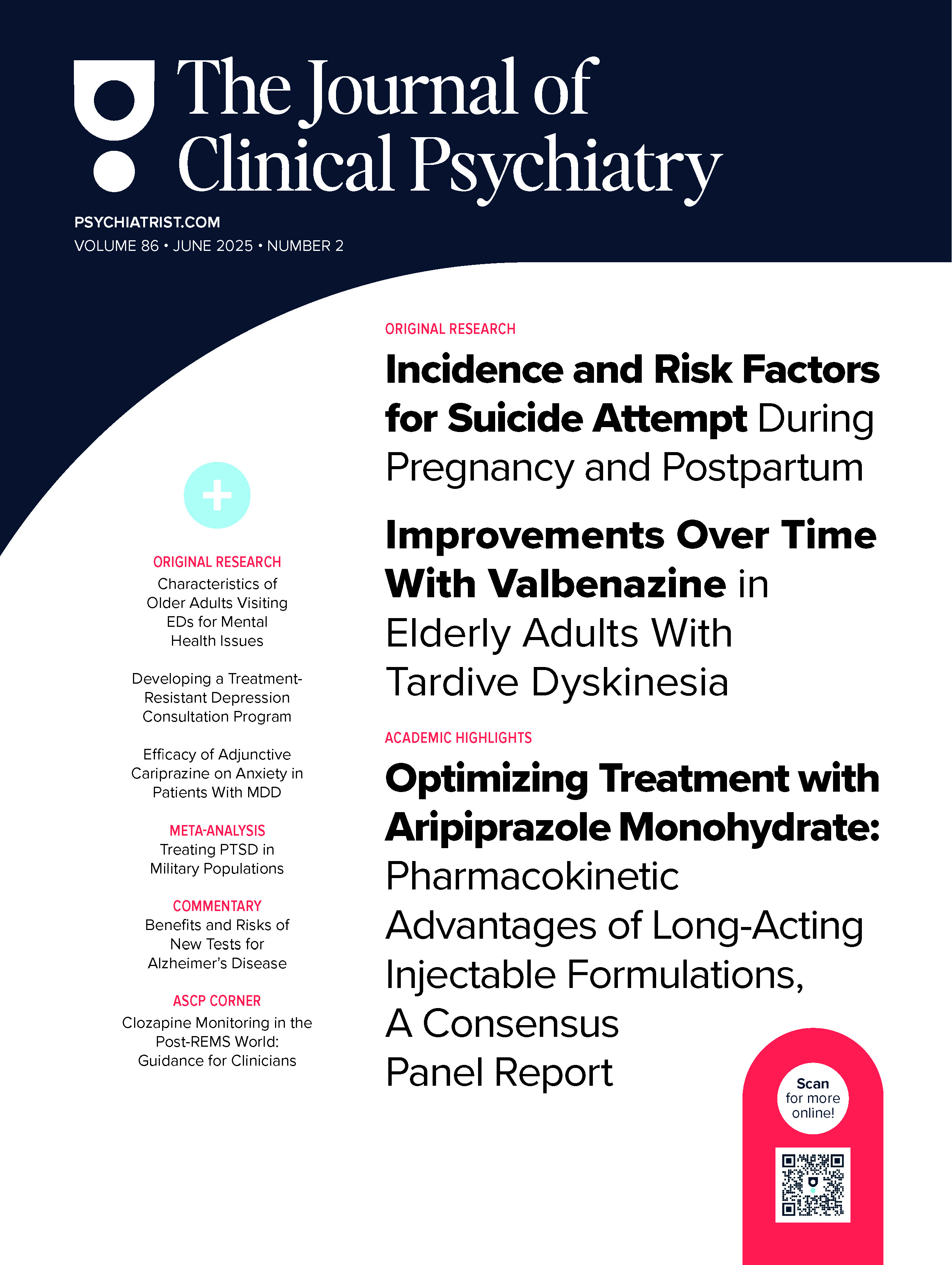Abstract
Objective: The effectiveness of antidepressant treatment for mood disorders is often limited by either a poor response or the emergence of adverse effects. These complications often necessitate multiple drug trials. This clinical challenge intensifies during pregnancy, when medications must be selected to improve the likelihood of response and optimize reproductive outcomes. We determined the distribution of common pharmacogenetic variants, metabolizer phenotypes, past medication responses, and side effects in childbearing-aged individuals seeking treatment in a tertiary care perinatal mental health clinic.
Methods: Sixty treatment-seeking women (based on sex at birth) with DSM-5– defined bipolar disorder (n = 28) or major depressive disorder (n = 32) provided DNA samples and completed psychiatric diagnostic and severity assessments between April 2014 and December 2017. Samples were genotyped for single-nucleotide variants in drug metabolizing enzyme genes of commonly prescribed antidepressants (cytochrome P450 [CYP] 1A2, 2B6, 2C9, 2C19, 2D6, 3A4, and 3A5), and the frequency of normative metabolizer status was compared to reference populations data from Clinical Pharmacogenetics Implementation Consortium (CPIC) guidelines. The Antidepressant Treatment History Form was used to record historic medication trials and side effects.
Results: A significantly greater proportion of extensive metabolizers for CYP2B6 was observed in the study population when compared to CPIC population frequency databases in Caucasians (0.64 vs 0.43 [95% CI: 0.49–0.76]; P value = .006) and African Americans (0.71 vs 0.33 [95% CI: 0.29–0.96]; P value = .045). No significant association was found between metabolizer phenotype and the likelihood of a medication side effect.
Conclusion: Pharmacogenomic testing may have value for personalized prescribing in individuals capable of or considering pregnancy.
J Clin Psychiatry 2024;85(2):23m15024
Author affiliations are listed at the end of this article.
Members Only Content
This full article is available exclusively to Professional tier members. Subscribe now to unlock the HTML version and gain unlimited access to our entire library plus all PDFs. If you’re already a subscriber, please log in below to continue reading.
References (56)

- Bloom DE, Cafiero ET, Jané-Llopis E, et al. The Global Economic Burden of Noncommunicable Diseases. World Economic Forum; 2011. Accessed June 26, 2023. https://www3.weforum.org/docs/WEF_Harvard_HE_GlobalEconomicBurdenNonCommunicableDiseases_2011.pdf
- Rush AJ, Trivedi MH, Wisniewski SR, et al. Acute and longer-term outcomes in depressed outpatients requiring one or several treatment steps: a STAR*D report. Am J Psychiatry. 2006;163(11):1905–1917. PubMed CrossRef
- Brown LC, Stanton JD, Bharthi K, et al. Pharmacogenomic testing and depressive symptom remission: a systematic review and meta-analysis of prospective, controlled clinical trials. Clin Pharmacol Ther. 2022;112(6):1303–1317. PubMed CrossRef
- Fabbri C, Tansey KE, Perlis RH, et al. Effect of cytochrome CYP2C19 metabolizing activity on antidepressant response and side effects: meta-analysis of data from genome-wide association studies. Eur Neuropsychopharmacol. 2018;28(8):945–954. PubMed CrossRef
- Relling MV, Klein TE. CPIC: clinical pharmacogenetics implementation consortium of the pharmacogenomics research network. Clin Pharmacol Ther. 2011;89(3):464–467. PubMed CrossRef
- Genetic testing and psychiatric disorders: a statement from the International Society of Psychiatric Genetics. International Society of Psychiatric Genetics. Accessed October 4, 2023. https://ispg.net/genetictesting-statement/
- Table of pharmacogenetic associations. U.S. Food and Drug Administration. October 26, 2022. Accessed June 27, 2023. https://www.fda.gov/medicaldevices/precision-medicine/table-pharmacogenetic-associations
- Hicks JK, Bishop JR, Sangkuhl K, et al. Clinical pharmacogenetics implementation consortium (CPIC) guideline for CYP2D6 and CYP2C19 genotypes and dosing of selective serotonin reuptake inhibitors. Clin Pharmacol Ther. 2015;98(2):127–134. PubMed CrossRef
- Greden JF, Rosthschild AJ, Thase M, et al. 49 combinatorial pharmacogenomics to guide treatment selection for major depressive disorder: a large, blinded, randomized controlled trial. CNS Spectrums. 2019;24(1):202–203.
- Winner JG, Carhart JM, Altar CA, et al. A prospective, randomized, double-blind study assessing the clinical impact of integrated pharmacogenomic testing for major depressive disorder. Discov Med. 2013;16(89):219–227. PubMed
- Hodgson K, Tansey KE, Uher R, et al. Exploring the role of drug-metabolising enzymes in antidepressant side effects. Psychopharmacology (Berl). 2015;232(14):2609–2617. PubMed CrossRef
- Hodgson K, Tansey K, Dernovsek MZ, et al. Genetic differences in cytochrome P450 enzymes and antidepressant treatment response. J Psychopharmacol (Oxf). 2014;28(2):133–141. PubMed CrossRef
- Veldic M, Ahmed AT, Blacker CJ, et al. Cytochrome P450 2C19 poor metabolizer phenotype in treatment resistant depression: treatment and diagnostic implications. Front Pharmacol. 2019;10:83. PubMed
- Pérez V, Salavert A, Espadaler J, et al. Efficacy of prospective pharmacogenetic testing in the treatment of major depressive disorder: results of a randomized, double-blind clinical trial. BMC Psychiatry. 2017;17:250. PubMed
- Hippman C, Slomp C, Morris E, et al. A cross-sectional study of the relationship between CYP2D6 and CYP2C19 variations and depression symptoms, for women taking SSRIs during pregnancy. Arch Womens Ment Health. 2022;25(2):355–365. PubMed
- Gaynes BN, Gavin N, Meltzer-Brody S, et al. Perinatal depression: prevalence, screening accuracy, and screening outcomes. Evid Rep Technol Assess (Summ). 2005;(119):1–8. PubMed CrossRef
- Wisner KL, Sit DKY, McShea MC, et al. Onset timing, thoughts of self-harm, and diagnoses in postpartum women with screen-positive depression findings. JAMA Psychiatry. 2013;70(5):490–498. PubMed CrossRef
- Mitchell AA, Gilboa SM, Werler MM, et al. Medication use during pregnancy, with particular focus on prescription drugs: 1976–2008. Am J Obstet Gynecol. 2011;205(1):51.e1–51.e8. PubMed CrossRef
- Cohen LS, Altshuler LL, Harlow BL, et al. Relapse of major depression during pregnancy in women who maintain or discontinue antidepressant treatment. JAMA. 2006;295(5):499–507. PubMed CrossRef
- Yonkers KA, Gotman N, Smith MV, et al. Does antidepressant use attenuate the risk of a major depressive episode in pregnancy? Epidemiology. 2011;22(6):848–854. PubMed CrossRef
- Feghali M, Venkataramanan R, Caritis S. Pharmacokinetics of drugs in pregnancy. Semin Perinatol. 2015;39(7):512–519. PubMed CrossRef
- Tracy TS, Venkataramanan R, Glover DD, et al. National Institute for Child Health and Human Development Network of Maternal-Fetal-Medicine Units. Temporal changes in drug metabolism (CYP1A2, CYP2D6 and CYP3A activity) during pregnancy. Am J Obstet Gynecol. 2005;192(2):633–639. PubMed CrossRef
- Sit DK, Perel JM, Helsel JC, et al. Changes in antidepressant metabolism and dosing across pregnancy and early postpartum. J Clin Psychiatry. 2008;69(4):652–658. PubMed CrossRef
- Anderson GD. Pregnancy-induced changes in pharmacokinetics: a mechanistic based approach: a mechanistic-based approach. Clin Pharmacokinet. 2005;44(10):989–1008. PubMed CrossRef
- Fay EE, Czuba LC, Sager JE, et al. Pregnancy has no clinically significant effect on the pharmacokinetics of bupropion or its metabolites. Ther Drug Monit. 2021;43(6):780–788. PubMed CrossRef
- Kreitchmann R, Schalkwijk S, Best B, et al. Efavirenz pharmacokinetics during pregnancy and infant washout. Antivir Ther. 2019;24(2):95–103. PubMed CrossRef
- Duloxetine Pathway, Pharmacokinetics. PharmGKB. Accessed May 29, 2023. https://www.pharmgkb.org/pathway/PA166255221
- Sirot EJ, Harenberg S, Vandel P, et al. Multicenter study on the clinical effectiveness, pharmacokinetics, and pharmacogenetics of mirtazapine in depression. J Clin Psychopharmacol. 2012;32(5):622–629. PubMed
- Okubo M, Murayama N, Miura J, et al. Effects of cytochrome P450 2D6 and 3A5 genotypes and possible coadministered medicines on the metabolic clearance of antidepressant mirtazapine in Japanese patients. Biochem Pharmacol. 2015;93(1):104–109. PubMed CrossRef
- Ververs FFT, Voorbij HAM, Zwarts P, et al. Effect of cytochrome P450 2D6 genotype on maternal paroxetine plasma concentrations during pregnancy. Clin Pharmacokinet. 2009;48(10):677–683. PubMed CrossRef
- Paroxetine Pathway, Pharmacokinetics. PharmGKB. Accessed May 29, 2023. http://pharmgkb.org/pathway/PA166121347
- Bupropion Pathway, Pharmacokinetics. PharmGKB. Accessed May 29, 2023. https://www.pharmgkb.org/pathway/PA166170276
- Sertraline Pathway, Pharmacokinetics. PharmGKB. Accessed May 29, 2023. https://www.pharmgkb.org/pathway/PA166181117
- Johansson M, Strahm E, Rane A, et al. CYP2C8 and CYP2C9 mRNA expression profile in the human fetus. Front Genet. 2014;5:58. PubMed CrossRef
- Citalopram and Escitalopram Pathway, Pharmacokinetics. PharmGKB. Accessed May 29, 2023. https://www.pharmgkb.org/pathway/PA164713429
- Fluoxetine Pathway, Pharmacokinetics. PharmGKB. Accessed May 29, 2023. https://www.pharmgkb.org/pathway/PA161749012
- Venlafaxine Pathway, Pharmacokinetics. PharmGKB. Accessed May 29, 2023. https://www.pharmgkb.org/pathway/PA166014758
- Trazodone Pathway, Pharmacokinetics. PharmGKB. Accessed May 29, 2023. https://www.pharmgkb.org/pathway/PA166280701
- Mlugu EM, Minzi OM, Kamuhabwa AAR, et al. Pregnancy increases CYP3A enzymes activity as measured by the 4β-hydroxycholesterol/cholesterol ratio. Int J Mol Sci. 2022;23(23):15168. PubMed CrossRef
- Boinpally R, Gad N, Gupta S, et al. Influence of CYP3A4 induction/inhibition on the pharmacokinetics of vilazodone in healthy subjects. Clin Ther. 2014;36(11):1638–1649. PubMed CrossRef
- Gene-specific information tables for CYP3A5. PharmGKB. Accessed May 3, 2023. https://www.pharmgkb.org/page/cyp3a5RefMaterials
- Sheehan DV, Lecrubier Y, Sheehan KH, et al. The Mini-International Neuropsychiatric Interview (M.I.N.I.): the development and validation of a structured diagnostic psychiatric interview for DSM-IV and ICD-10. J Clin Psychiatry. 1998;59(suppl 20):22–33; quiz 34–57. PubMed
- Sackeim HA. The definition and meaning of treatment-resistant depression. J Clin Psychiatry. 2001;62(suppl 16):10–17. PubMed
- Rush AJ, Gullion CM, Basco MR, et al. The Inventory of Depressive Symptomatology (IDS): psychometric properties. Psychol Med. 1996;26(3):477–486. PubMed CrossRef
- Spitzer RL, Kroenke K, Williams JBW, et al. A brief measure for assessing generalized anxiety disorder: the GAD-7. Arch Intern Med. 2006;166(10):1092–1097. PubMed CrossRef
- Guidelines. Cpicpgx.org. Accessed May 3, 2023. https://cpicpgx.org/guidelines/
- PGx gene-specific information tables. PharmGKB. Accessed May 3, 2023. https://www.pharmgkb.org/page/pgxGeneRef
- Gene-specific information tables for CYP2B6. PharmGKB. Accessed May 3, 2023. https://www.pharmgkb.org/page/cyp2b6RefMaterials
- Gene-specific information tables for CYP2C19. PharmGKB. Accessed May 3, 2023. https://www.pharmgkb.org/page/cyp2c19RefMaterials
- Gene-specific information tables for CYP2C9. PharmGKB. Accessed May 3, 2023. https://www.pharmgkb.org/page/cyp2c9RefMaterials
- Gene-specific information tables for CYP2D6. PharmGKB. Accessed May 3, 2023. https://www.pharmgkb.org/page/cyp2d6RefMaterials
- CYP2C9 CDS table. Cpicpgx.org. Accessed May 3, 2023. https://files.cpicpgx.org/data/report/current/gene_cds/CYP2C9_CDS.xlsx
- CYP2D6 CDS table. Cpicpgx.org. Accessed May 3, 2023. https://files.cpicpgx.org/data/report/current/gene_cds/CYP2D6_CDS.xlsx
- Stika CS, Wisner KL, George AL Jr, et al. Changes in sertraline plasma concentrations across pregnancy and postpartum. Clin Pharmacol Ther. 2022;112(6):1280–1290. PubMed CrossRef
- Fukasawa T, Suzuki A, Otani K. Effects of genetic polymorphism of cytochrome P450 enzymes on the pharmacokinetics of benzodiazepines. J Clin Pharm Ther. 2007;32(4):333–341. PubMed CrossRef
- Antipsychotics Pathway. PharmGKB. Accessed October 28, 2023. https://www.pharmgkb.org/pathway/PA166170742





